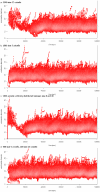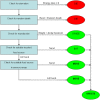The emergence of predators in early life: there was no Garden of Eden
- PMID: 19492046
- PMCID: PMC2685975
- DOI: 10.1371/journal.pone.0005507
The emergence of predators in early life: there was no Garden of Eden
Abstract
Background: Eukaryote cells are suggested to arise somewhere between 0.85~2.7 billion years ago. However, in the present world of unicellular organisms, cells that derive their food and metabolic energy from larger cells engulfing smaller cells (phagocytosis) are almost exclusively eukaryotic. Combining these propositions, that eukaryotes were the first phagocytotic predators and that they arose only 0.85~2.7 billion years ago, leads to an unexpected prediction of a long period (approximately 1-3 billion years) with no phagocytotes -- a veritable Garden of Eden.
Methodology: We test whether such a long period is reasonable by simulating a population of very simple unicellular organisms -- given only basic physical, biological and ecological principles. Under a wide range of initial conditions, cellular specialization occurs early in evolution; we find a range of cell types from small specialized primary producers to larger opportunistic or specialized predators.
Conclusions: Both strategies, specialized smaller cells and phagocytotic larger cells are apparently fundamental biological strategies that are expected to arise early in cellular evolution. Such early predators could have been 'prokaryotes', but if the earliest cells on the eukaryote lineage were predators then this explains most of their characteristic features.
Conflict of interest statement
Figures



Similar articles
-
Physiology, anaerobes, and the origin of mitosing cells 50 years on.J Theor Biol. 2017 Dec 7;434:2-10. doi: 10.1016/j.jtbi.2017.01.004. Epub 2017 Jan 11. J Theor Biol. 2017. PMID: 28087421 Review.
-
Interactions between the direct and indirect effects of predators determine life history evolution in a killifish.Proc Natl Acad Sci U S A. 2008 Jan 15;105(2):594-9. doi: 10.1073/pnas.0710051105. Epub 2008 Jan 7. Proc Natl Acad Sci U S A. 2008. PMID: 18180455 Free PMC article.
-
Introduction to the Special Issue on Early Evolution and the Last Common Ancestor.J Mol Evol. 2024 Oct;92(5):527-529. doi: 10.1007/s00239-024-10208-6. Epub 2024 Sep 20. J Mol Evol. 2024. PMID: 39304551 Free PMC article.
-
The phagotrophic origin of eukaryotes and phylogenetic classification of Protozoa.Int J Syst Evol Microbiol. 2002 Mar;52(Pt 2):297-354. doi: 10.1099/00207713-52-2-297. Int J Syst Evol Microbiol. 2002. PMID: 11931142 Review.
-
Plastid evolution.Annu Rev Plant Biol. 2008;59:491-517. doi: 10.1146/annurev.arplant.59.032607.092915. Annu Rev Plant Biol. 2008. PMID: 18315522 Review.
Cited by
-
An overview of the introns-first theory.J Mol Evol. 2009 Nov;69(5):527-40. doi: 10.1007/s00239-009-9279-5. Epub 2009 Sep 24. J Mol Evol. 2009. PMID: 19777149
-
The relative ages of eukaryotes and akaryotes.J Mol Evol. 2014 Dec;79(5-6):228-39. doi: 10.1007/s00239-014-9643-y. Epub 2014 Sep 2. J Mol Evol. 2014. PMID: 25179144
-
Cell Death in Evolutionary Transitions in Individuality.Yale J Biol Med. 2019 Dec 20;92(4):651-662. eCollection 2019 Dec. Yale J Biol Med. 2019. PMID: 31866780 Free PMC article. Review.
-
Molecular ontogeny of the stomach in the catshark Scyliorhinus canicula.Sci Rep. 2019 Jan 24;9(1):586. doi: 10.1038/s41598-018-36413-0. Sci Rep. 2019. PMID: 30679499 Free PMC article.
-
Division of labour in a matrix, rather than phagocytosis or endosymbiosis, as a route for the origin of eukaryotic cells.Biol Direct. 2020 Apr 28;15(1):8. doi: 10.1186/s13062-020-00260-9. Biol Direct. 2020. PMID: 32345370 Free PMC article.
References
-
- Cavalier-Smith T. The phagotrophic origin of eukaryotes and phylogenetic classification of protozoa. Int J Syst Evol Microbiol. 2002;52:297–354. (doi:10.1099/ijs.0.02058-0.) - PubMed
-
- Jurkevitch E. Predatory behaviors in bacteria—diversity and transitions. Microbe. 2007;2:67–73.
-
- Bengtson S. Origins and early evolution of predation. Paleontol Soc Pap. 2002;8:289–317.
-
- Embley M, Martin W. Eukaryotic evolution, changes and challenges. Nature. 2006;440:623–630. (doi:10.1038/nature04546.) - PubMed
Publication types
MeSH terms
LinkOut - more resources
Full Text Sources

